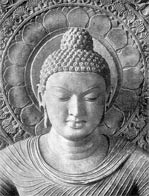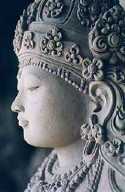The Buddhist Path...
and The One Light

Siddhartha Gautama was born and educated as a Hindu, and was deeply
saddened as he saw the suffering of those who were confused and
embattled in conflicting beliefs over their many gods. Those with little
understanding were fighting over foolish matters such as whether or not
Rama was greater than Krishna or Shiva.
Indeed, Siddhartha was deeply saddened by the pain and suffering that he
saw in the world, and set out to discover a path whereby one could rise
above the differences and distinctions of mankind in order to enjoy a
life beyond suffering.
He saw that on-going arguments over whether or not "my god is better
than your god" were not bringing insight to mankind, but were actually
resulting in painful division, misunderstanding, hatred and violence. He
saw that instead of the people's belief in Brahman bringing them
together in peace, their religion often led to petty bickering over
which gods, goddesses and attributes were superior. Siddhartha also
noted that many unenlightened teachers were leading the people astray
and using either the love of God or the wrath of God as the reason for
every action. But that approach was leading only to more pain and
suffering.
Over time, Siddhartha was shown that there was another path, a path that
would rise far above and beyond such arguments, divisiveness and hatred.
Shakyamuni Buddha taught that if a person had been shot with an arrow,
there was really no point in a group of people standing around arguing
over who made the arrow, or what type of wood it was made of, or what
type of feathers were used. The first, and most important matter, is
simply to remove the arrow.
 Shakyamuni had awakened to the truth that only when one has discovered
true peace is he truly ready and able to discover the glorious depths
and wonders of Life. So,
rather than starting off with the divisive and contentious issue of God
and His attributes, the teachings of Shakyamuni simply began with
learning how to be a good human being, learning how to live with
loving-kindness, respect and harmony for all of creation.
Shakyamuni had awakened to the truth that only when one has discovered
true peace is he truly ready and able to discover the glorious depths
and wonders of Life. So,
rather than starting off with the divisive and contentious issue of God
and His attributes, the teachings of Shakyamuni simply began with
learning how to be a good human being, learning how to live with
loving-kindness, respect and harmony for all of creation.
While there are many possible paths leading to a life of love, harmony
and beauty, we generally see that any one teacher will tend to use
certain specific concepts and ideals in his teaching; and so it was that
Shakyamuni began to teach the people about the causes of their
suffering.
Shakyamuni taught that there is no need to even mention the ideal called
God or Allah or Krishna or the All-Mighty Ever-Seeing One in order to
learn the truth of suffering. So, the great innovation in his teaching
was that he did not use either the love of God or the wrath of God as a
reason to live in harmony with one another, he completely side-stepped
such contentious issues, and began to teach about crucial issues for
living a peaceful and mindful life, such as the Four Heavenly Abodes:
loving-kindness (metta), compassion (karuna), sympathetic joy (mudita)
and equanimity (upekkha).
This path was of course very successful because people were, and still
are, eager to put an end to their suffering. However, as is the case
with every path toward understanding, the followers of the teaching did
not always comprehend where this path would lead. For many, the teaching
of Buddha was merely a refuge from suffering, and thus many believe that
there is no God in Buddhism. And, for them, that is therefore true. But
that is not the fault of the teachings of Shakyamuni.
Every person has their own unique definition of 'God'. Indeed, each
person has their own special understanding of God; for some, there is a
personal God; for others there is an unknowable God. Thus, many of the
arguments about God stem from the simple fact that God is beyond
definition.
I once saw the Dalai Lama Tenzin Gyatso talking about his early days of
learning science and how he began to see the wonder and magnificence of
the intelligence that was in some manner behind the existence of all the
stars and planets.... How delightful!
In the peace and mindfulness offered by Buddhism, he had indeed seen
beyond the beyond, and had acknowledged that Mystery beyond the
mysteries that many would call God. In general, the Buddhist path
recognizes that there is an essential radiance (also called luminosity
or purity) that forms the basis of our awareness and which permeates and
supports our existence. Again, some would simply call that radiance God,
or and aspect of God, but it is not the name that matters. What really
matters is that we allow this glorious purity, regardless of what we
call it, to manifest in our lives as compassion and loving-kindness.
That is our true nature, and that is our highest calling.
There are many paths to perfection, and each person is offered
their own personal path out of their own particular darkness and pain.
Each person has their own unique path, and we must willingly allow each
of our brothers and sisters to walk their own unique path... not only
allow them to walk their own path, but we should happily celebrate their
path and encourage them along their way no matter how different their
path may seem to be.
There is only One Light shining through every window... call it
Buddha-nature, call it Divine Essence, call it God, the name doesn't
really matter; it is only the direct personal experience and
manifestation of that essence
that really matters. So, go for it! Every person has this glorious
essence, the essence of enlightenment, already within them, let it out,
let it shine!!
Wishing you love, harmony and beauty,
wahiduddin
posted January 09, 2005